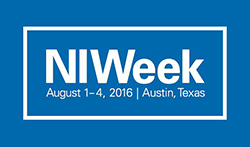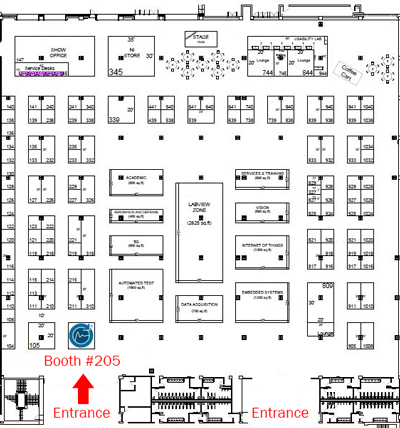The exceptional team of Bloomy is gearing up for a historic NIWeek 2016, the 22nd annual conference for software-defined systems in measurement and control, to be held on August 1st-4th at the Austin Convention Center in Austin, TX. This is an especially exciting conference, as Bloomy will partner with National Instruments (NI) to unveil the NI Hardware-In-the-Loop (HIL) Simulator Concept System for the first time! Look out for this transformative new system in the keynote and on the exhibition floor. Speaking of HIL, Bloomy and Jaguar Land Rover have co-authored an NI Engineering Impact Award submission on battery management system (BMS) HIL testing that is a finalist in the Transportation and Heavy Equipment category.  Visit the display poster to be featured on the main concourse to learn how Jaguar Land Rover reduces BMS firmware release times, while increasing confidence, using Bloomy’s BMS HIL Test System. In addition, Bloomy’s world-class engineering team will provide four technical sessions spanning topics such as LabVIEW user experiences, TestStand hardware and measurement abstraction, advanced battery testing trends and technologies, as well as BMS lifecycle testing. These presentations will be supplemented with exhibits in the expo hall, featuring aerospace real-time test, electronic assembly functional test, and battery test and simulation. Check us out and see why we are the leader in automated test, data acquisition and control systems using NI technology!
Visit the display poster to be featured on the main concourse to learn how Jaguar Land Rover reduces BMS firmware release times, while increasing confidence, using Bloomy’s BMS HIL Test System. In addition, Bloomy’s world-class engineering team will provide four technical sessions spanning topics such as LabVIEW user experiences, TestStand hardware and measurement abstraction, advanced battery testing trends and technologies, as well as BMS lifecycle testing. These presentations will be supplemented with exhibits in the expo hall, featuring aerospace real-time test, electronic assembly functional test, and battery test and simulation. Check us out and see why we are the leader in automated test, data acquisition and control systems using NI technology!
Exhibits
Stop by the Bloomy pavilion in booth #205 to experience our innovative products and platforms with applications in aerospace real-time test, electronic assembly functional test, and battery testing and simulation.
 The NI HIL Simulator Concept System incorporates NI platforms and architectures to create flexible closed-loop simulations for real-time testing of a wide range of devices. This highly-integrated platform scales to address devices with small I/O quantities up to complex systems with thousands of I/O points. Functionality is achieved using the latest NI PXI components in combination with a new NI extension for switching, loads and signal conditioning (SLSC); as well as VeriStand real-time test software, in a highly-accessible 19-inch rack. Bloomy provides the expertise to integrate these systems for aerospace and defense customers, providing more cost-effective systems for HIL testing with substantially faster lead times than traditional VME or other HIL systems.
The NI HIL Simulator Concept System incorporates NI platforms and architectures to create flexible closed-loop simulations for real-time testing of a wide range of devices. This highly-integrated platform scales to address devices with small I/O quantities up to complex systems with thousands of I/O points. Functionality is achieved using the latest NI PXI components in combination with a new NI extension for switching, loads and signal conditioning (SLSC); as well as VeriStand real-time test software, in a highly-accessible 19-inch rack. Bloomy provides the expertise to integrate these systems for aerospace and defense customers, providing more cost-effective systems for HIL testing with substantially faster lead times than traditional VME or other HIL systems.
The system includes a wide variety of sensor simulations, which are specifically designed to address the HIL testing needs of aerospace and defense customers. For example, aerospace applications benefit from the platform's inclusion of VDT, resolver, synchro and thermocouple simulations, as well as ARINC 429 and MIL-STD-1553; just to name a few. Coupled with NI's VeriStand real-time test software, aerospace companies will be able to integrate their own models from Simulink and other standard model sources, including C/C++, Fortran, and many others1. This combination of off-the-shelf technologies and a powerful real-time environment addresses testing a wide variety of aerospace electronics assemblies, such as electronic engine controls, flight control computers, and subsystem controllers. The system also scales up for use in system integration laboratories (SILs), and the platform's available switching modules provide an unmatched, off-the-shelf ability to switch between simulated components and real components, and to provide multiple methods of fault insertion.
Bloomy is proud to partner with National Instruments to deliver this NI HIL Simulator Concept System with its unparalleled level of flexibility and off-the-shelf lead times, backed by NI's unwavering commitment to long-term availability and customer support. Bloomy contributed its vast aerospace test experience to the original specifications development, and is providing several of the SLSC modules, as well as integration of turnkey HIL systems for aerospace companies throughout the Americas.
1 For a list of supported modeling environments that have been tested and verified to be able to create compiled models that can be imported using NI Veristand, read Using Simulation Models with NI VeriStand.
The BMS HIL Demo is a small-scale demonstration of Bloomy’s BMS HIL Test System, an open system platform that hybrid and electric vehicle companies use for firmware development and regression testing of battery management systems (BMS). Learn how you can safely and efficiently simulate the characteristics of advanced Li-Ion batteries and battery systems using NI PXI hardware running VeriStand real-time test software, in tandem with Bloomy’s Battery Simulator 1200 and Battery Fault Insertion Unit. The working demonstration shows how a BMS responds to cell imbalances, thermal runaway, overvoltage, open- and short-circuit faults, and many other common Li-Ion battery states.
The UTSTM Software Suite functional test exhibit demonstrates how companies can improve the quality of their test development and deployment, while reducing their time and effort. The UTSTM Software Suite’s hardware abstraction layer (HAL), operator interface (OI), and database reporting (DB) provide the most common software functionality required for automated test systems, allowing test engineers to focus on the specifics of testing products, rather than the tedium of developing and maintaining a full-featured test software architecture. A sample unit under test (UUT) consisting of an electronic printed circuit board assembly (PCBA) will be tested on two flavors of test systems from Bloomy’s UTSTM family of electronics functional testers: the entry-level USB-based compactUTS, and the modular PXI-based UTS. Attendees will receive a demonstration of the benefits of each platform, as well as the UTSTM Software Suite’s three major components:
Hardware Access Framework - provides an intuitive way to develop test sequences independent of specific instrumentation and platforms. Signal-based step types make UUT-centric actions and measurements easy to implement, and file-based hardware configurations mean that tests can be executed with varying instrumentation without the need to modify the TestStand sequence. In the demonstration, an identical sequence will be used to test the UUT on the two very different platforms.
Operator Interface - a standard interface that is optimized for a manufacturing environment with touchscreen and barcode scanner-driven usage. The UTS Software Suite’s operator interface (OI) allows operators and manufacturing engineers to easily execute the right test sequence with the right hardware for a particular UUT. The OI will show how test sequences can be mapped to UUTs and fixtures, to make test management extremely intuitive. Additional features like debugging, diagnostics, and UUT image and feedback all improve the operator experience.
Database Reporting - a plugin for NI TestStand that makes database setup and result processing fast and easy to implement. Visitors will see how easy it is to view, filter, and export results using built-in SQL queries.
Select visitors will receive Bloomy-branded light-up yo-yos commemorating the recent registration of the Bloomy trademark (but please disregard the “TM” symbol and imagine that it’s really “®”). There will be an informal yo-yo trick contest during the NIWeek expo party on Tuesday August 2nd from 7:00-7:30 PM. The winner will receive a Fitbit.
Presentations
Several members of Bloomy’s world-class engineering team will present the following technical sessions. Attendees are encouraged to pre-register for these sessions using the conference mobile application.
TS 9890 - From the Experts: Improving ATE Test Sequence Adaptability Using HALs and MALs
Presented by Grant Gothing
Tuesday, August 2nd @ 2:15-2:45 PM, Room 12A
Do you maintain multiple test systems or develop test sequences for a wide range of products? Have you ever experienced the hassles of instrumentation or platform changes? If so, hardware and measurement abstraction layers (HAL & MALs) can save you time, money, and frustration by reducing the impact of hardware changes, maximizing code reuse, and reducing development effort. In this session we will describe the benefits and challenges of abstraction in ATE. By presenting common options for implementing HALs and MALs, from out-of-the-box drivers through object-oriented solutions, we will help you decide right scope of abstraction to fit your needs.
TS 9923 - Advanced Battery Testing Trends and Technologies
Presented by Peter Blume
Wednesday, August 3rd @ 11:00-11:30 AM, Ballroom G
Advancements in electrochemical battery technologies and the ever-growing breadth of applications pose many testing challenges for battery manufacturers, OEMs and test labs. A wide variety tests are performed at the cell, module, and pack levels. In this presentation, Peter Blume will present a few of the latest trends in battery research and development, and corresponding test techniques including cell characterization, safety and abuse testing, battery simulation, hardware-in-the-loop testing, and end-of-line manufacturing test. Peter will present several application case studies including custom and commercial-off-the-shelf test solutions based on NI hardware and software.
TS 9903 - Test Challenges and Solutions for Advanced Battery Management System Test
Presented by Steven Hoenig
Wednesday, August 3rd, 4:45- 5:15 PM, Ballroom E
A battery management system (BMS) is an embedded system that controls critical battery functions on modern electric vehicles. It is typically tested throughout the development process to optimize control algorithms through manufacturing and ensure reliable functionality. Learn how to successfully implement a flexible test system family for automating the full range of BMS test, including hardware-in-the-loop, validation, and manufacturing test. Explore the capabilities and architectures of these systems that are built on LabVIEW, TestStand, and VeriStand software and PXI and CompactRIO hardware. Discover the advantages of using a consistent platform to deliver a BMS to market faster and more reliably.
TS 9636 - Creating Effective User Experiences in LabVIEW™ Applications
Presented by Ryan Vallieres
Thursday, August 4th @ 10:30-11:30 AM, Room 16A
How we display information to the user is critical to the success of the applications we develop. There’s a lot of data. It’s simple to focus on collecting and recording that data and forget that we need to present that data to another human being. A user interface should be intuitive and clear and should contain contextually important information. At this session, explore visual design concepts, information architecture, and valuable architectures and constructs for an effective LabVIEW user interface. Hear some of the presenter’s personal failures and successes trying to create great user experiences in LabVIEW.
Related Links
Follow us on Twitter for NIWeek updates!
